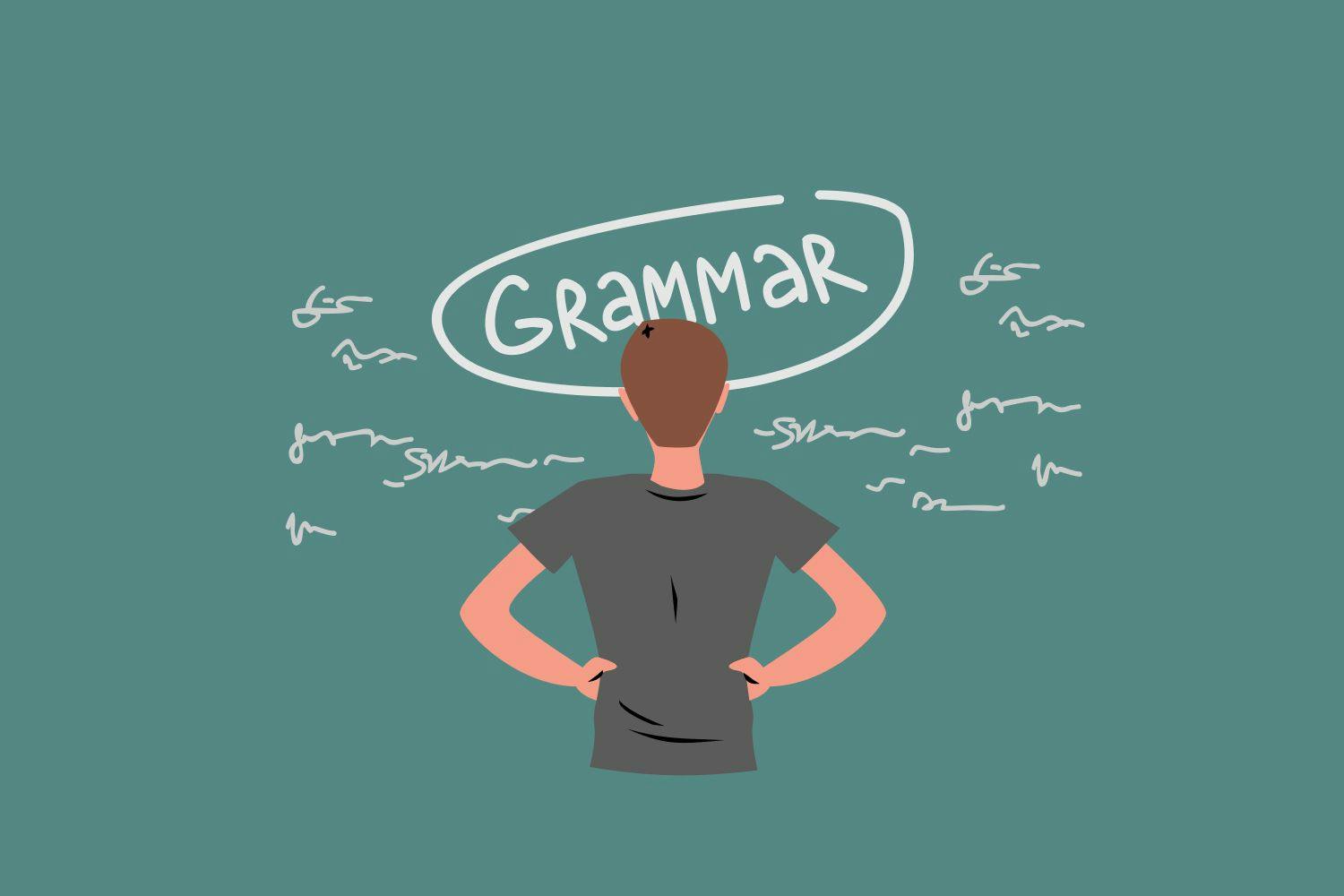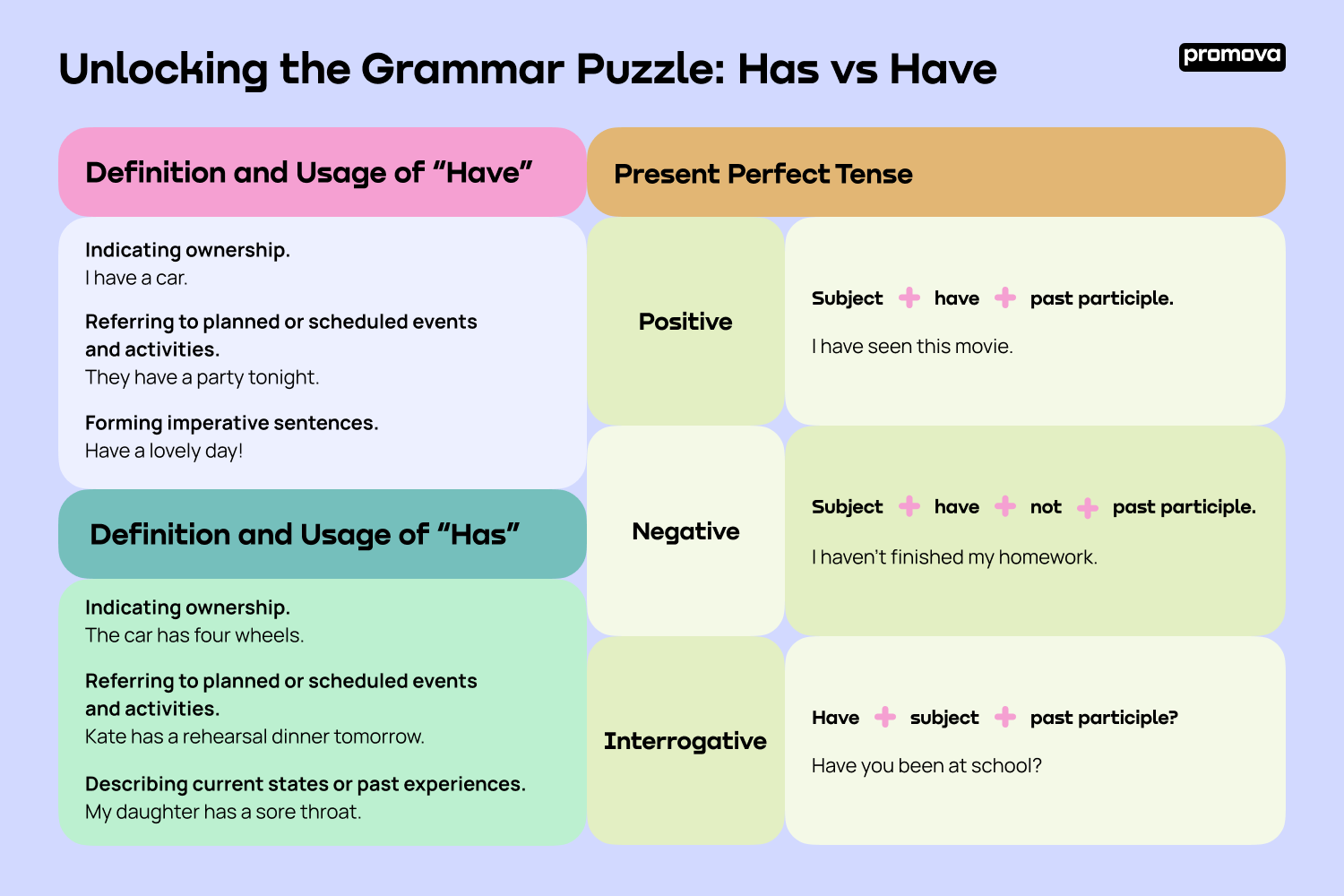Unlocking the Grammar Puzzle: Has vs Have

Contents
Understanding English grammar is one of the vital parts of a successful language-learning process. Among the intricacies of grammar, the proper usage of verbs holds a significant place. In particular, the distinction between has vs have is crucial in conveying precise meaning and ensuring grammatical accuracy. In this article, we will delve into the nuances of these words to provide a comprehensive idea of their usage.
Understanding Has vs Have Grammar
To comprehend the difference between these verbs, we need to take a closer look at each of them separately. Both of today’s words can be used in distinct ways in sentences – as main, helping, or modal verbs. It is essential to determine them and implement them into appropriate contexts to avoid any misunderstandings. So, when to use has or have? Let’s find out together.
Definition and Usage of “Have”
The verb “have” is one of the most common in English, with over a dozen meanings. It can be the main verb in the sentence or a modal. The word “have” is usually used in the first- and second-person singular and plural, and the third-person plural. It can be employed in various contexts:
- Indicating ownership.
I have a car.
We have two dogs.
- Referring to planned or scheduled events and activities.
I have a meeting at 8 o’clock today.
They have a party tonight.
- Describing current states or past experiences in negative and interrogative sentences with has and have.
Did you have a good time in Alabama?
I have a terrible headache.
- Forming imperative sentences.
Have a lovely day!
Have a seat, please.
As you can see, most statements with “have” as the main verb have the same structure. It is similar to most usage contexts and differs only by the types of sentences.
| Positive | Subject + have + object. |
| Negative | Subject + don’t/doesn’t + have + object. |
| Interrogative | Do/does + subject + have + object? |
So, what part of the speech is have? We can confidently say it is a verb, main or modal, depending on the circumstances. As an auxiliary verb, it is mainly used to create different tenses. Let’s take a more in-depth look at them.
- Indicating the requirement and describing something that is needed to be done.
I have to go now.
They have to finish their homework.
- Present Perfect Tense.
Used to indicate an action that started in the past and is connected to the present. It emphasizes the completion or experience of the action.
| Positive | Subject + have + past participle. | I have seen this movie. |
| Negative | Subject + have + not + past participle. | I haven’t finished my homework. |
| Interrogative | Have + subject + past participle? | Have you been at school? |
- Past Perfect Tense.
Used to indicate an action that occurred before another past action. It shows that something was completed before a specific point in the past.
| Positive | Subject + had + past participle. | They had already left when I arrived. |
| Negative | Subject + had + not + past participle. | She hadn’t studied for the exam before she took it. |
| Interrogative | Had + subject + past participle? | Had they visited that place before? |
- Future Perfect Tense.
Used to express an action that will be completed before a specific future time or event.
| Positive | Subject + will have + past participle. | By the time you arrive, I will have finished cooking dinner. |
| Negative | Subject + will not + have + past participle. | We will not have reached our destination by nightfall. |
| Interrogative | Will + subject + have + past participle? | Will they have arrived at the airport by noon? |
- Present Perfect Continuous Tense.
Emphasizes the ongoing nature of an action that started in the past and continues up to the present.
| Positive | Subject + have/has been + present participle (-ing form). | We have been studying for hours. |
| Negative | Subject + have/has + not + been + present participle. | They haven’t been paying attention in class. |
| Interrogative | Have/Has + subject + been + present participle? | Has she been taking acting lessons? |
- Past Perfect Continuous Tense.
Indicates a continuous action that started in the past and continued up to a specific point in the past.
| Positive | Subject + had been + present participle (-ing form). | She had been living in that city for five years before she moved. |
| Negative | Subject + had + not + been + present participle. | I hadn’t been exercising regularly before I joined the gym. |
| Interrogative | Had + subject + been + present participle? | Had she been studying all night before the exam? |
Definition and Usage of “Has”
The difference between has and have is quite simple. “Has” is the third-person singular form of the verb “have” used in conjunction with he/she/it pronouns or singular nouns in present tense contexts. It can also be both a main and an auxiliary verb and have the same ways of usage. Look at these examples.
- Indicating ownership.
John has an Intermediate fluency level.
The car has four wheels.
- Referring to planned or scheduled events and activities.
Kate has a rehearsal dinner tomorrow.
He has a job interview on Friday.
- Describing current states or past experiences.
The child has a fever.
My daughter has a sore throat.
- Indicating the requirement and describing something that is needed to be done.
He has to learn how to cook.
She has to end their toxic relationship.
- Present Perfect Tense.
She has visited Paris multiple times.
The team has won the championship.
He has finished reading the book.
- Present Perfect Continuous Tense.
She has been studying for the exam all week.
The architect has been constructing the project for several months.
He has been waiting for the bus for over an hour.

Common Mistakes and How to Avoid Them
Now you know when to use has or have in different circumstances and sentences. However, we can’t deny that this topic is quite challenging. Therefore, it can cause a lot of mistakes and misunderstandings. Let’s cover the most common ones.
- Subject-verb agreement. The verb “have” must agree with the subject in number. Some people often forget about this grammar rule when choosing between has or have.
Incorrect: She have a daughter. They has a big house.
Correct: She has a daughter. They have a big house.
- Incorrect tense usage. In some tenses, including Past and Future Perfect or Past Perfect Continuous, we can only use the verb “have.” However, sometimes people use the verb “has” instead, which is grammatically incorrect.
Incorrect: He has already left when I arrived. She will has finished her work by tomorrow.
Correct: He had already left when I arrived. She will have finished her work by tomorrow.
These are the most common mistakes people make when learning about the has and have difference. However, don’t let it scare you. There are always ways to easily nail this topic and memorize all the key rules. Pay attention to the details, understand the context, and learn to determine whether the verb is main or auxiliary in a particular sentence. Remember, practice makes perfect, and we know that by putting in some effort, you will quickly master this complex topic.
13
Have versus Has: Understand the Difference with Promova
While learning a new language can be fascinating, it might be a bit complicated for unprepared students, especially regarding grammar rules. To help you achieve your language-learning goals more quickly and efficiently, we want to introduce you to Promova – a cutting-edge language-learning platform tailored to your needs.
We understand that every learner is unique. Therefore, we offer both personal and group lessons with our team of professional tutors; they will ensure that you receive the highest quality education and guidance. Curious to experience the features of our platform beforehand? We offer a free trial lesson, allowing you to explore our resources and communicate with the tutors before making a commitment.
Of course, we won’t stop there. We believe in the power of communication to truly solidify language skills. That is why we offer a free Conversation Club, where you can connect with language enthusiasts from around the globe.
For your comfort, we also offer a convenient Promova app, allowing you to dive into your lessons, track progress, and practice regardless of where you are. Don’t miss the opportunity to revolutionize your language-learning journey. Join us today and unlock a world of possibilities.
Conclusion
To sum up, this grammar topic is quite complex, and it requires some effort to memorize all the rules. Yet, today you’ve learned a lot about these similar verbs. Now you know the definition of the verbs “have” and “has,” how to use them in different contexts, is has singular or plural, and what is the main distinction between them. We hope this article was helpful, and looking forward to seeing you in the next one!
FAQ
Can “has” and “have” be used interchangeably in all situations?
While the has and have meaning is typically the same, these verbs can’t be used interchangeably. The main difference between these verbs is that “has” is usually used with singular subjects (e.g., he, she, it), while “have” is connected with plural subjects (e.g., they, we, you). Mixing up this usage can lead to misunderstandings and grammatical errors.
Are there any exceptions when using “has” and “have”?
Yes, there are two exceptions. First, in interrogative sentences in the present, we use the verb “have” with any subject (Does he have a car? Will she have dinner with us?). Another exception is the combination of the pronouns “she” and “he” in the same sentence. In this case, we also always use the verb have (He and she have a daughter. She and he have a big house in London.)
Can “has” or “have” be used in future tenses?
The verb “has” can only be used in present tenses. The usage of the word “have,” on the other hand, is also appropriate in the Future Perfect and Future Perfect Continuous tenses, indicating the action that will be done before a specific point in time.
Are there any fixed phrases with the verb “have”?
Yes, there are many of them! For example, such expressions as “have a chat/talk with someone,” “have a baby,” “have a problem,” and “have dinner/breakfast” are always used with this verb.
Comments